Ford Mustang (1999-2004) Service Manual: Disc and Pressure Plate - 3.8L and 4.6L (2V) Engines
Special Tool(s)
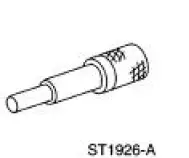 |
Clutch Aligner 308-020 (T74P-7137-K) |
Material
| Item | Specification |
| Premium Long Life Grease XG-1-C | ESA-M1C75-B |
1. Remove the transmission.
2. CAUTION: Loosen the bolts evenly to prevent clutch pressure plate damage.
NOTE: If the parts are to be reused, mark the clutch pressure plate and the flywheel.
Remove the bolts and remove the clutch pressure plate and the clutch disc.
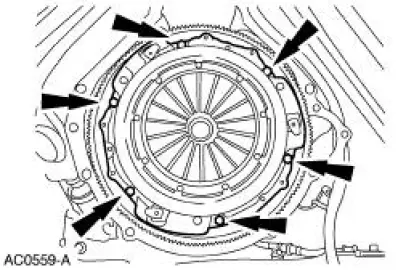
Installation
NOTE: Clean the clutch pressure plate and flywheel with a commercial alcohol-based solvent so surfaces are free from oil film.
Do not use cleaners with a petroleum base. Do not immerse the clutch pressure plate in the solvent.
1. Position the clutch disc on the flywheel.
- Using the special tool, align the clutch disc.
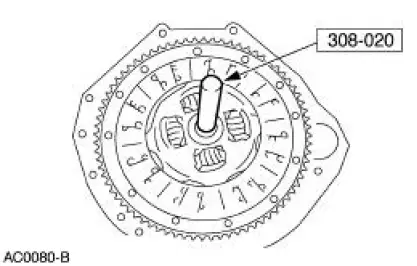
2. NOTE: If reusing the clutch pressure plate, align the plate using the marks made during removal.
Using the special tool, align the clutch pressure plate and install it on the dowels.
- Install the bolts in the sequence shown.
- Remove the special tool.
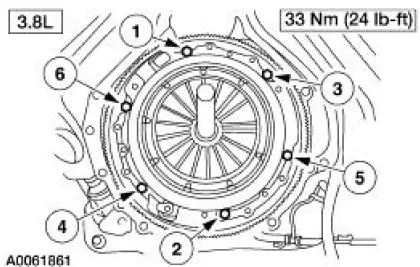
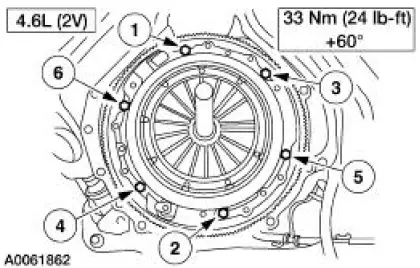
3. NOTE: Before installing the transmission, the ball stud, the clutch release lever and the input shaft must be cleaned and lubricated with grease.
Install the transmission.
 Clutch (Description and Operation)
Clutch (Description and Operation)
The primary function of the clutch is to couple and uncouple engine power
to the transmission upon
driver command.
The clutch is a single plate, dry friction clutch disc. The clutch
disc ha ...
 Disc and Pressure Plate - 4.6L (4V) Engine
Disc and Pressure Plate - 4.6L (4V) Engine
Special Tool(s)
Clutch Aligner
308-020 (T74P-7137-K)
Material
Item
Specification
Premium Long Life Grease
XG-1-C
ESA-M1C75-B
1. Disconnect the battery ground cable. ...
Other materials:
Switch - Deactivator
Removal
1. Disconnect the battery ground cable.
2. Remove the deactivator switch.
1. Disconnect the deactivator switch electrical connector.
2. Detach the lower deactivator switch hook.
3. Detach the upper deactivator pivot.
Installation
1. N ...
Stabilizer Bar - Cobra
Removal
CAUTION: Suspension fasteners are critical parts because they affect
performance of vital
components and systems and their failure can result in major service expense. A
new part with
the same part number must be installed if installation becomes nec ...
Digital Transmission Range (TR) Sensor
Special Tool(s)
Alignment Gauge, TR Sensor
307-351 (T97L-70010-A)
Removal
1. Disconnect the battery ground cable. For additional information, refer
to Section.
2. Raise and support the vehicle. For additional information, refer to
Sectio ...
